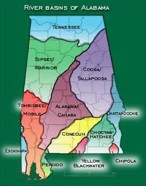A Publication of The League of Women Voters of Greater Birmingham
Published June 2007
 Earlier this year, the Alabama Rivers Alliance and Southern
Environmental Law Center released "Alabama Water Agenda: Guiding the
Way to Healthy Waters". This is a very readable report which can be
downloaded at www.AlabamaWaterAgenda.com. I will summarize threats to
Alabama water as described in the report in this Voter and policy
changes that the AL Water Agenda proposes to combat the threats in the
next Voter. Earlier this year, the Alabama Rivers Alliance and Southern
Environmental Law Center released "Alabama Water Agenda: Guiding the
Way to Healthy Waters". This is a very readable report which can be
downloaded at www.AlabamaWaterAgenda.com. I will summarize threats to
Alabama water as described in the report in this Voter and policy
changes that the AL Water Agenda proposes to combat the threats in the
next Voter. -- Leonette Slay |
As we all know, Alabama is a water-rich state, containing over 77,000 miles of rivers and streams. All precipitation becomes part of one of 14 major river basins. As a result of our diverse waterways, Alabama ranks fifth in the nation in plant and animal diversity and first in freshwater species diversity. Protecting our waterways is therefore vital to sustaining our tremendous array of native species as well as the people, economy, and wildlife that depend on the water.
Of the 77,000 miles of water in Alabama, the Alabama Department of Environmental Management (ADEM) has only analyzed 7%. Of this 7%, a whopping 40% is considered to have poor water quality. A number of grassroots organizations have been working for decades to protect and improve our state waters. The agenda published in January (from which this information is taken) was developed from comments and direction of nine grass roots groups* and speaks to those areas with the most potential for success through policy changes. Four main areas of water health were considered to formulate actual or potential threats: water quality, water quantity, public health, and aquatic communities.
Our water quality is threatened by both direct and indirect pollution. The main sources of pollution are land development, agriculture, urban storm water runoff, and surface mining. In the area of water quantity, the major threats are excessive unregulated water withdrawals, excessive flooding within urban areas, and increasing demand for water supply for both local and out-of-state entities. Our public health is put at risk through pollution (bacteria and toxins) and fish that are unsafe to eat. Because of poor water quality, waterborne illnesses put thousands of citizens and state visitors at risk each year. Finally, aquatic communities must be protected from in-stream erosion, degraded water quality, sedimentation, and loss of stream bank vegetation. A thriving aquatic community indicates a healthy watershed. This, in turn, promotes the economy and tourism. The Alabama Water Agenda maintains that a comprehensive state water program will ensure that the four categories of water health discussed above are maintained for future Alabamians. In the next Voter, the policy strategy of this group will be summarized. We can examine this strategy in light of LWVAL positions on the environment.
*Of the 70 groups in AL dedicated to protecting water and wetlands, here are the nine that formed the peer review for the AL Water Agenda: Black Warrior Riverkeeper; Cahaba River Society; Choctawhatchee Riverkeeper; Flint River Conservation Association; Friends of Rural Alabama; Lake Watch of Lake Martin; Legal Environmental Assistance Foundation; Dan Murchison; and Save Our Soughahatchee.
-- Leonette Slay
Look for Leonette’s article in the next Voter on the policy changes being proposed.

Click here
to print
or
click the browser "print" button
call 205 583-5000 or visit on-line at www.lwvgb.org